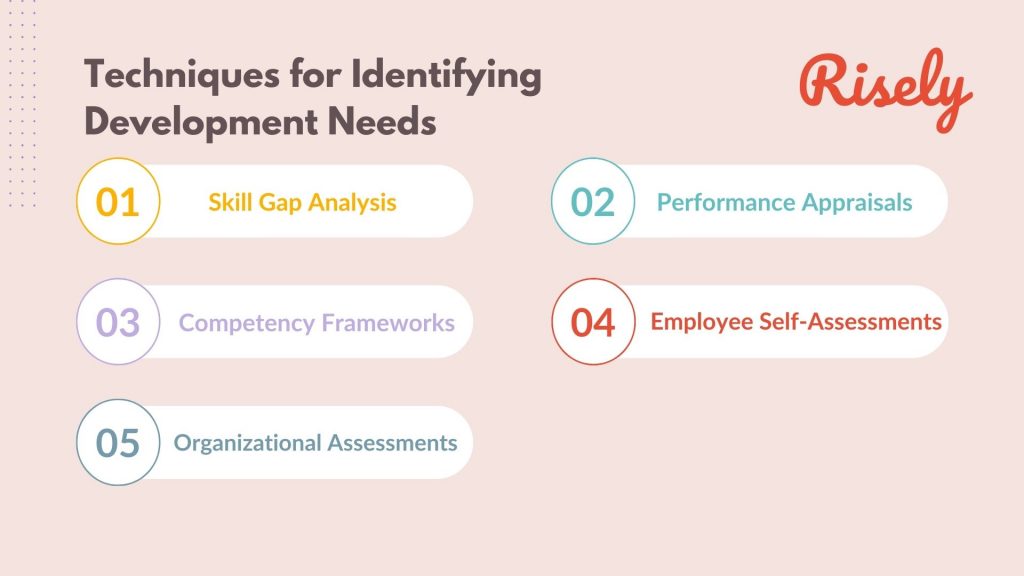6 Solid Techniques to Identify the Development Needs of Your Team
Your team is the backbone of your organization, and as a manager, it’s your responsibility to ensure that they are equipped with the tools they need to succeed. Identifying development needs is crucial for ensuring your team continually grows and reaches its full potential. In this blog , we’ll dive into the techniques you can use to identify your team’s development needs and provide tips for managers to help them develop a growth plan. From understanding the importance of development needs analysis to encourage open communication, this post will equip you with everything you need to help your team thrive. So let’s get started!Understanding Development Needs
What are the development needs of employees?
“Development needs” of employees refer to areas where they may require additional training, skill-building, or support to grow and advance in their role. It could include things like improving communication skills, learning new software or technology, developing leadership abilities, or enhancing job-specific skills. Identifying and addressing development needs helps employees feel more engaged and fulfilled while improving overall performance and productivity. Therefore, managers must regularly assess their team member’s focus areas and provide training, mentorship, and growth opportunities to support their ongoing professional development.What is a Development Needs Analysis?
Identifying the development needs of your team is crucial for their growth and your team’s success. Development Needs analysis is a process that can help you achieve this. DNA involves identifying the gaps between your team’s current skills, competencies, and desired ones. This process helps assess individual strengths and weaknesses, identify areas for improvement, and create a plan for training and development that will help your team grow. Identifying the development needs of your team can be a challenging task. However, it is essential for improving team productivity and overall job satisfaction. Development Needs Analysis is a comprehensive process that gathers information from multiple sources, including employees, managers, and performance data. By identifying skill gaps hindering team growth and productivity, you can create targeted training programs to help your employees develop the skills and knowledge they need to succeed. Practical identification of development areas at work is an ongoing process, as employee development needs will change over time. Lets dive into techniques of identifying development needs in detail. Read more about why your team needs this: Why Training and Development is Important for Teams?
Techniques for Identifying Development Needs
Identifying development needs is crucial for the growth of both employees and the organization. To achieve this, learning and development managers can conduct regular performance evaluations to identify areas of improvement and offer targeted training programs. Soliciting feedback from team members can also help determine their development goals, which can be used to create personalized development plans. Additionally, analyzing industry trends and future growth opportunities can help identify emerging skills necessary for your team’s success. By employing these techniques, organizations can ensure their team members receive the support needed to reach their full potential.Skill Gap Analysis
Identifying skill gaps is critical to determining your team’s development needs. Skill gap analysis, as the name suggests, involves analyzing the difference between your team’s skills and the skills they need to perform their job effectively. This process helps create a personalized training plan for each team member based on their identified development areas. Learning and development managers can undertake skill gap analysis through various methods such as surveys, assessments, and performance evaluations. It is an effective tool for identifying areas where additional training or development is required. You can help your team develop new skills and improve their overall performance by identifying skill gaps. By the way, if you are a manager looking for ways to measure your key leadership skills, Risely has got you covered! Risely offers an interesting set of leadership skill assessments for managers and leaders to evaluate and improve their skills such as effective delegation, active listening, and strategic thinking. Assessing your skills marks the first step toward a journey of growing into the leader you have always wanted to be. Get started now:- Leadership Skills Assessments by Risely
- Free Downloadable Skills Gap Analysis Template
- Free Downloadable Skills Matrix Analysis Template
Other Interesting Reads
Performance Appraisals
Performance appraisals are an essential tool for identifying the development needs of your team. They allow managers to assess employee performance objectively and provide constructive feedback on areas that need improvement. By setting clear and objective criteria, managers can ensure fairness and accuracy in their assessments. Moreover, regular follow-up meetings can help track progress and make adjustments as needed. Overall, conducting performance appraisals is one of the most effective ways to identify the development needs of your team and help them achieve their full potential.Competency Frameworks
Competency frameworks are an excellent tool for identifying development needs in your team. They offer a structured approach to defining the skills, knowledge, and behaviors required for success in a particular job or role. By creating a competency framework tailored to your team’s needs, you can identify gaps in your team’s skills and knowledge. In addition, it helps to learn and development managers set precise performance and career development expectations and create a personalized training plan for each team member based on their identified development needs.Employee Self-Assessments
Encouraging employees to participate in self-assessments can be an effective way to identify their development needs. These assessments can offer insight into areas where team members feel they could improve and allow them to take ownership of their growth. By providing clear guidelines and expectations, managers can ensure that the self-assessments are accurate and helpful. When used in conjunction with other techniques like performance reviews and observations, employee self-assessments can provide a well-rounded view of potential development areas within the team. Check out self-assessments of leadership skills by Risely: Leadership Skills AssessmentsOrganizational Assessments
Assessing your organization can be a valuable tool for identifying areas that need improvement. By gathering feedback from employees through surveys, interviews, or focus groups, you can identify the strengths and weaknesses of your team. This information can then be used to develop targeted training programs that address areas needing improvement. In addition, organizational assessments can help identify potential leaders within the organization while also communicating to employees the purpose and benefits of the evaluation to ensure their participation and buy-in. Finally, regularly conducting these assessments can help ensure your team is always on the right track toward achieving success.Bonus: Get started now!
You can start your own and your team’s learning journey now with Risely in just a few clicks! Risely offers a range of learning and development resources, including a handy training needs analysis which you can start working with instantly!Make identification of training needs easier with Risely’s free template!
Download Risely’s training needs analysis template and rejuvenate L&D at your workplace.
Tips for Managers in Identifying Development Needs
Apart from formal methods of identifying the development needs of team members, learning and development managers can also take the help of daily workplace activities to understand the development areas of team members.Encourage Open Communication
Effective communication is essential for identifying and addressing the development needs of your team. Encouraging open communication with team members can help you better understand their strengths, areas for improvement and career goals. One way to do this is by scheduling regular one-on-one meetings where you can discuss their progress and development goals. It is crucial to create a safe space where team members feel comfortable sharing their thoughts and ideas openly. Managers should actively listen to team members’ concerns and challenges raised by them and take note of them. By doing so, they can create an individualized development plan for each team member that helps track their progress toward achieving their goals.Set SMART Goals
Setting SMART goals is a crucial part of identifying and meeting the development areas of your team. These goals are specific, measurable, achievable, relevant, and time-bound. By setting SMART goals, you can identify the skills or knowledge your team needs to develop and provide a clear roadmap for achieving development objectives. It’s essential to involve your team members in setting their own SMART goals to ensure they feel invested in their growth and development.Regularly Assess Progress and Reassess Development Needs
Assessing the progress of your team members is a crucial step in identifying their development needs. Regularly monitoring their growth helps you identify gaps in their skills or knowledge, allowing you to provide targeted training and support. One-on-one meetings can provide valuable feedback on strengths and areas for improvement while also providing an opportunity to set new development goals. In addition, it’s important to reassess development areas periodically as new challenges arise or goals change, ensuring your team stays aligned with the evolving needs of your organization. By continually assessing progress and reassessing development needs, you can ensure your team members are equipped with the skills they need to succeed.Conclusion
Identifying your team’s development needs is crucial for any organization’s growth and success. It helps learn and develop managers to address skill gaps and motivates employees to improve their performance, ultimately leading to better business outcomes. They can identify development areas needing improvement using skill gap analysis, performance appraisals, and competency frameworks. As a manager, it’s essential to encourage communication and set SMART goals while regularly assessing progress and reassessing development needs. When you invest in your team’s development, you create a culture of continuous learning and improvement.Make identification of training needs easier with Risely’s free template!
Download Risely’s training needs analysis template and rejuvenate L&D at your workplace.
Frequently Asked Questions
What are the developmental needs?
Developmental needs are areas where an individual requires additional knowledge, skills, or experience to reach their full potential. These may be identified through performance evaluations, feedback from colleagues, or self-reflection.
What are professional development needs?
Professional development needs refer to the ongoing learning and growth required to enhance an individual’s professional skills and knowledge. This can include attending workshops, taking courses, and seeking mentorship opportunities.
What are development needs in organization?
Development needs in an organization refer to areas where the organization requires additional capabilities to meet its strategic goals. These may include developing new products or services, expanding into new markets, or improving internal processes.
How are development needs identified?
Development needs are identified through various methods, including performance reviews, employee feedback, and gap analyses. By assessing an individual’s current skills and competencies and comparing them to the organization’s needs, development needs can be identified and addressed through targeted training and development programs.
Other Related Blogs
How To Build Learner Personas For L&D? Free Template
How To Build Learner Personas For L&D? Free Template For every learning designer, the root question is who will use this content. All your actions to ensure that the learning…
How To Use A Learning And Development Maturity Model?
How To Use A Learning And Development Maturity Model? How strong is your organization on the learning and development front? Answering that question is not super simple. Many factors are…
Learning Experience Platforms: A Brief Introduction
Learning Experience Platforms: A Brief Introduction When it comes to technology that supports workplace learning, our minds race to LMS. The humble learning management systems support a plethora of courses,…
7 Gen Z Workplace Expectations From A Manager
7 Gen Z Workplace Expectations From A Manager More and more members of Generation Z (Gen Z) are entering the workforce every year, and they are already challenging traditional workplace…


